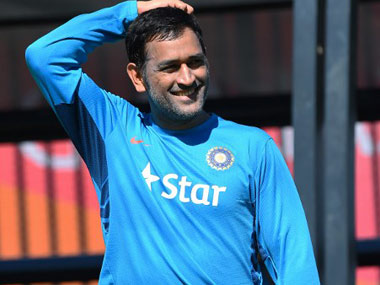Mahendra Singh Dhoni has announced his retirement from his role as captain of the Indian limited overs side (while still being available for selection as a player). He had retired from Tests (and thereby given up captaincy) during the away tour in Australia in December 2014. He has led India in 60 Tests (27 wins, 15 draws, 18 losses), 199 ODIs (110 wins and 74 losses) and 73 T20Is (41 wins and 28 losses). He was at the helm when India were number one ranked Test side in 2009; led them to a world cup victory in 2011 at home, and gatecrashed the sport as the leader of the T20 side in 2007 winning the inaugural edition of WT20.
Dhoni’s achievements as the wicket-keeper batsman that held the post of captain, for so long, in a nation that is so cricket mad, where every win is praised to the heavens and every loss gets panned roundly, will have few rivals, if any, around the sporting world, let alone in cricket. It wouldn’t be an exaggeration to say that his relinquishing of captaincy from all formats for India is the end of an era.
For all of Dhoni’s accomplishments as India’s captain, his methods were limited. He was more keen to draw the opposition in to a staring contest, and had the wherewithals to hold his own more often in not blinking first. He was a master at pushing a game to the last over, to the last run, to the last ball and had the confidence that his ability to handle human frailties of feeling the pressure of the situation would win out over the opponents'.
Dhoni, in his first Test as the full time captain, taking over from Anil Kumble, gave terrific insights in to his defensive methods to winning Tests. He asked his bowlers to bowl wide of off stump with a 8-1 field in wanting to see whether the Australians would blink first. And they did. Of course, there is no shame in using defensive methods to win a Test but by and large, that was Dhoni’s go to approach to making something happen.
He was instinctively defensive as a captain, wanting to slow the flow of runs, rather than aiming for wickets. It can be argued that the bowling resources he had at his disposal all but restrained from trying anything else, but in the same vein, it can also be argued that Dhoni’s defensive philosophy – of posting perpetual boundary riders and bowling dry to control the runs first and foremost – did not allow his bowlers to be more confident and successful.
His methods of captaincy served him very well and were trustworthy in limited overs matches where as the limits of his methods were exposed in the Test arena. Followers of Indian cricket will fondly look back on many matches that Dhoni featured with his bat in a run chase or made moves that pulled the rabbit out of the hat. I’m sure the World T20 win in 2007 where he threw the ball to Joginder Sharma for the final over would appear quite high on the list, as would the use of Ishant Sharma at the death in the 2013 Champions Trophy final.
For all the accolades that have come Dhoni’s way for Pakistan falling short by 5 runs, it escapes scrutiny that Pakistan were in with a shot in the final over facing a no name bowler because India let go of a situation where Pakistan needed 54 runs in four overs with just three wickets in hand! Dhoni’s option for the 20th over was either Joginder Sharma or Harbhajan Singh who was walloped for three sixes in the 16th over by Misbah. It was a forced move as much as an inspired choice. In games of T20, the line is thin and almost non-existent.
Similarly, in the Champions Trophy final, Dhoni employed Ishant to bowl the 18th over (of a reduced over match) even though he had overs available for Umesh Yadav and Bhuvaneshwar Kumar - both had been economical on the day. Ishant had gone for 11 in his third over and began his fourth disastrously but eventually took the wickets of two set batsmen and India went on to win the trophy.
During a presser in the tri-series that followed in the Caribbean, I’d asked Dhoni about his logic of using Ishant for the 18th over when other pace options were available. He paused for a moment, and responded with a typical impish smile, “Those are my secrets. If I tell you everything now, what will I have to put in my book when I write it?”. I was taking him seriously and yet he didn’t extend that courtesy to me. That’s another facet of Dhoni as a captain that beggared belief, and frustrated in equal amounts with his need for control and holding everything close to his chest. Without Dhoni explaining his choices, I was left with the belief that he just got lucky (unless his book, whenever that comes out, details otherwise).
Dhoni always preferred bowlers who gave him control over those that could provide him breakthroughs albeit at higher expense. He always seemed to believe that if he could control the runs, he could control the game. It worked more for him in ODIs and T20s, and even in Tests when he could use bowler like Ravindra Jadeja to tie up one end, but when conditions were such where he couldn’t control the run rate, the dam broke wide open.
Dhoni’s calculative mind was at its best in run chases. He is considered the best finisher in limited over games. It was in full view when he shepherded Number nine, ten and Jack to a win over Sri Lanka in the final of the aforementioned tri-series. He ended up scoring 45 of the 63 runs that India needed when he came in, for the win. This was Dhoni’s staring contest at its best. He pushed the contest to the very last over, when the odds were in his favour, facing an inexperienced Shaminda Eranga. With 15 required off the last six balls, there was an air of inevitability as Eranga began the over. Sure enough, Dhoni wrapped the game up in four balls including a thunderous six that landed on top of the media centre. Indian fans, for quite some time, were used to that feeling in a run chase, when Dhoni was out in the middle.
Dhoni the batsman, especially in limited over games, covered up a lot of the deficiencies of Dhoni the captain. He achieved remarkable highs as a captain with three major trophy wins (and tremendous IPL success) that it is easy to be seduced in to thinking that his captaincy across formats was near flawless.
I’m a practicing Engineer and a trained scientist. I see the aspects of cricket captaincy through those prisms. An engineer’s job is to provide solutions to problems where as a scientist essentially deals with open-ended questions. After spending nearly half a decade at trying to become a scientist, I realized my forte was in providing solutions to questions with definite answers. Cricket captaincy, in limited over games, is like that of an Engineer, dealing with finite set of possibilities where as Test cricket with its unraveling over five days is more of an open-ended question where the possibilities, if you will, are endless.
Dhoni was in his elements as a captain when faced with finite amount of runs and deliveries, and seemed to not really be with it when faced with challenges of Test cricket. He was an Engineer, and not a scientist, as a cricket captain, and there is no shame in it, as he was a damn fine Engineer, the best India has had.


)




)
)
)
)
)
)
)
)